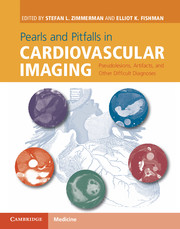 Pearls and Pitfalls in Cardiovascular Imaging
Pearls and Pitfalls in Cardiovascular Imaging from Section 3 - Anatomic variants and congenital lesions
Published online by Cambridge University Press: 05 June 2015
Imaging description
Bicuspid aortic valves are congenital malformations of the aortic valve that result in two functional aortic valve leaflets. In the majority of cases, the right and left aortic cusps are fused with a central raphe, or ridge, that is variable in size. On static images of the aortic valve acquired in diastole with either cardiac CT or MRI, a bicuspid valve with prominent raphe will have an appearance that mimics a tricuspid valve (Figure 26.1). However, dynamic images obtained during systole will reliably demonstrate the restricted motion of the fused valve and typical fish-mouth appearance of the aortic valve orifice using either modality. Bicuspid valves are also typically morphologically abnormal with leaflet thickening and calcification commonly identified, that can suggest further investigation (Figure 26.2). Fusion occurs between the left and right cusps in the majority of patients.
Importance
Recognition of a bicuspid valve is important given the increased risk of aortic stenosis, regurgitation, aneurysm, and dissection. Patients with bicuspid valve are closely followed with serial echocardiography to assess valve and ventricular function.
Typical clinical scenario
Bicuspid aortic valve is the most common congenital cardiovascular abnormality, affecting 1–2% of the population. Bicuspid valve morphology is highly variable; however, fusion of the right and left cusps with a midline raphe is the most common pattern, found in 59% of cases in one large series. Patients with bicuspid valve may be referred to cardiac CT or MRI for assessment of coronary arteries, ventricular function, or aortic size. Bicuspid valves may also be an incidental finding on cardiac imaging exams performed for other indications.
Differential diagnosis
Tricuspid aortic valve with acquired cusp fusion due to senile degeneration can be difficult to distinguish from congenitally bicuspid aortic valve with raphe given similar morphologies. Central calcification of the midline raphe, unequal cusp size, and the presence of an ascending aortic aneurysm are more commonly associated with bicuspid valves and can suggest the diagnosis.
To save this book to your Kindle, first ensure no-reply@cambridge.org is added to your Approved Personal Document E-mail List under your Personal Document Settings on the Manage Your Content and Devices page of your Amazon account. Then enter the ‘name’ part of your Kindle email address below. Find out more about saving to your Kindle.
Note you can select to save to either the @free.kindle.com or @kindle.com variations. ‘@free.kindle.com’ emails are free but can only be saved to your device when it is connected to wi-fi. ‘@kindle.com’ emails can be delivered even when you are not connected to wi-fi, but note that service fees apply.
Find out more about the Kindle Personal Document Service.
To save content items to your account, please confirm that you agree to abide by our usage policies. If this is the first time you use this feature, you will be asked to authorise Cambridge Core to connect with your account. Find out more about saving content to Dropbox.
To save content items to your account, please confirm that you agree to abide by our usage policies. If this is the first time you use this feature, you will be asked to authorise Cambridge Core to connect with your account. Find out more about saving content to Google Drive.